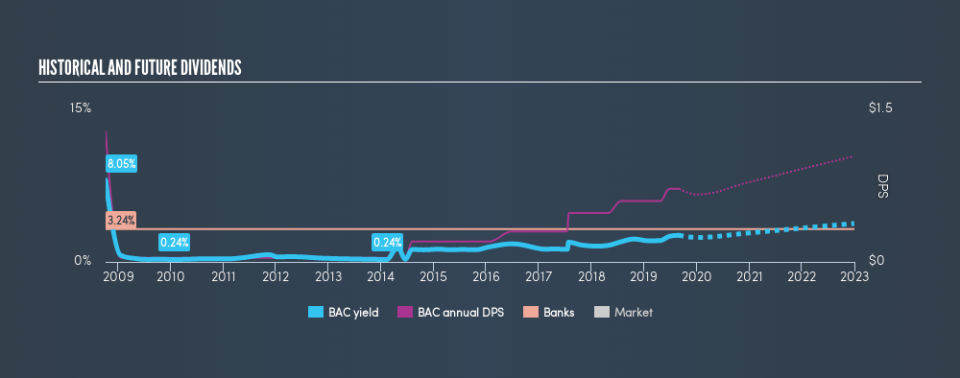Bank of America Corporation (NYSE:BAC) Looks Interesting, And It's About To Pay A Dividend

Readers hoping to buy Bank of America Corporation (NYSE:BAC) for its dividend will need to make their move shortly, as the stock is about to trade ex-dividend. You can purchase shares before the 5th of September in order to receive the dividend, which the company will pay on the 27th of September.
Bank of America's upcoming dividend is US$0.18 a share, following on from the last 12 months, when the company distributed a total of US$0.72 per share to shareholders. Last year's total dividend payments show that Bank of America has a trailing yield of 2.6% on the current share price of $27.51. We love seeing companies pay a dividend, but it's also important to be sure that laying the golden eggs isn't going to kill our golden goose! We need to see whether the dividend is covered by earnings and if it's growing.
See our latest analysis for Bank of America
Dividends are typically paid out of company income, so if a company pays out more than it earned, its dividend is usually at a higher risk of being cut. Bank of America is paying out just 21% of its profit after tax, which is comfortably low and leaves plenty of breathing room in the case of adverse events.
Companies that pay out less in dividends than they earn in profits generally have more sustainable dividends. The lower the payout ratio, the more wiggle room the business has before it could be forced to cut the dividend.
Click here to see the company's payout ratio, plus analyst estimates of its future dividends.
Have Earnings And Dividends Been Growing?
Companies with consistently growing earnings per share generally make the best dividend stocks, as they usually find it easier to grow dividends per share. If business enters a downturn and the dividend is cut, the company could see its value fall precipitously. It's encouraging to see Bank of America has grown its earnings rapidly, up 27% a year for the past five years.
The main way most investors will assess a company's dividend prospects is by checking the historical rate of dividend growth. Bank of America's dividend payments per share have declined at 5.6% per year on average over the past 10 years, which is uninspiring. Bank of America is a rare case where dividends have been decreasing at the same time as earnings per share have been improving. It's unusual to see, and could point to unstable conditions in the core business, or more rarely an intensified focus on reinvesting profits.
The Bottom Line
From a dividend perspective, should investors buy or avoid Bank of America? When companies are growing rapidly and retaining a majority of the profits within the business, it's usually a sign that reinvesting earnings creates more value than paying dividends to shareholders. Perhaps even more importantly - this can sometimes signal management is focused on the long term future of the business. In summary, Bank of America appears to have some promise as a dividend stock, and we'd suggest taking a closer look at it.
Wondering what the future holds for Bank of America? See what the 20 analysts we track are forecasting, with this visualisation of its historical and future estimated earnings and cash flow
We wouldn't recommend just buying the first dividend stock you see, though. Here's a list of interesting dividend stocks with a greater than 2% yield and an upcoming dividend.
We aim to bring you long-term focused research analysis driven by fundamental data. Note that our analysis may not factor in the latest price-sensitive company announcements or qualitative material.
If you spot an error that warrants correction, please contact the editor at editorial-team@simplywallst.com. This article by Simply Wall St is general in nature. It does not constitute a recommendation to buy or sell any stock, and does not take account of your objectives, or your financial situation. Simply Wall St has no position in the stocks mentioned. Thank you for reading.

